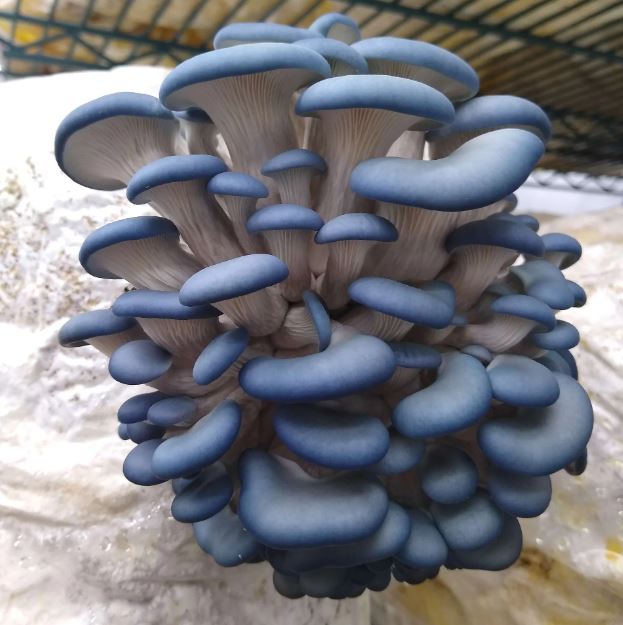
Blue Oyster (Pleurotus ostreatus)
Blue oyster mushrooms (Pleurotus ostreatus) may be the most well-known gourmet edible mushroom. They are one of the easiest to cultivate and are highly nutritious, making them a popular choice for home cultivators and commercial growers alike.
Blue Oyster mushrooms have a spongy, dense, and slightly chewy consistency. When raw, the mushrooms bear a scent reminiscent of the seashore combined with anise and have a subtly metallic flavor. Once cooked, Blue Oyster mushrooms soften, developing a velvety, tender texture and contain a mild, earthy, and savory taste with licorice-like nuances.
The size and shape can vary immensely depending on the growing conditions. Oyster mushrooms require an extremely high level of fresh air exchange, more so than any other mushroom commonly cultivated.
Grown in a high CO2 environment, Oyster mushrooms will have long, thick stems with small caps. If you see this your Oyster mushrooms need more fresh air.
Spawn Run
Incubate at room temperature for 14 -21 days. Watch for water pooling in the spawn, or “sweating”.
Initiate Pinning:
Drop temperature to 15 deg C. Increase humidity to 95%. Should start to pin in less than 7 days.
Fruit Development:
Humidity at 85%. Temperature at 15-20 deg C. Grow fast, should produce harvestable fruits in 5 days or less from pinning.
For starters, some studies have shown that blue oyster mushrooms lower cholesterol in rats significantly and may do the same in humans. Blue oyster mushroom benefits also include a plethora of valuable constituents, like proteins, amino acids, antioxidants, vitamins and minerals. They are rich in vitamin B and vitamin D. Iron and potassium are also present in these mushrooms. Blue oyster calories: It is said that a cup (86 g) of sliced blue oyster mushrooms has 37 calories.
Another test-tube study showed that oyster mushrooms helped reduce the secretion of inflammation markers throughout the body. Two additional studies looked at blue oyster mushroom benefits. One of the study conducted by the Methodist Research Institute’s Cancer Research Lab looked at oyster mushrooms and cancer, just as the study entitled Anti-Cancer Effects of Protein Extracts from Calvatia lilacina, Pleurotus ostreatus and Volvariella volvacea did.
YIELD:
Blue Oyster Mushrooms can achieve extremely high yields, up to 200% biological efficiency. Picking older mushrooms will improve the yield, but risks covering your grow room with spores or picking the mushroom past their prime for culinary use.
HARVEST:
Harvest the mushrooms by picking of or cutting off entire clusters.
Mushrooms will store longer if handled delicately and stored as a cluster instead of picking off individual mushrooms. Blue Oysters will store longer in the fridge than pinks or yellows.
Blue Oysters have the tendency to continue growing in the fridge, with mycelium starting to grow from the stems. This is usually undesirable. Blue Oyster mushrooms can also be dried in a dehydrator for long term storage.
WEAKNESS:
Blue Oysters have a huge spore load, more than any other mushroom.
They also have the largest fresh air requirement than any other gourmet mushroom, making it a bit of a challenge to grow large fruits indoors.
They last for a long time in the fridge but may start to grow mycelium from the stems. The stems can be chewy.
COOKING:
Blue Oyster mushrooms can be used in a variety of dishes, especially soups and pastas. The flavor is unique and delicious.
The stems can be chewy, and you may want to avoid using the stems in most dishes. Dried mushrooms can be re-hydrated in water or directly placed in soups and stews.